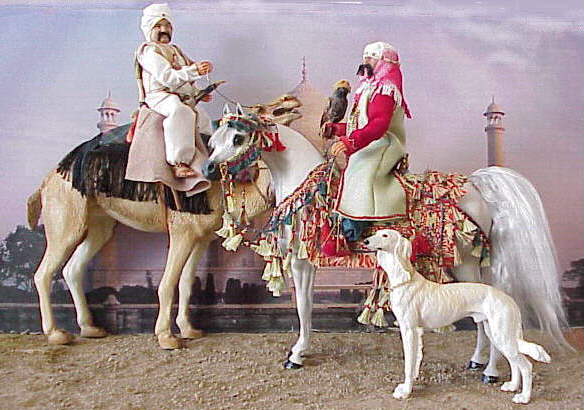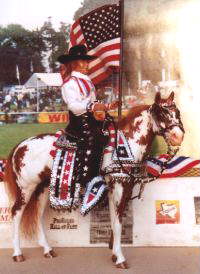| Classes Offered |
|
| Arabian Costume |
|
| Arabian Costume Overview by Kimberly Jacobs. |
|
| Arabian Costume Native Bedouin: Egyptian-Jordanian-Syrian, Omani, Yemeni, Saudi Arabian, Iraqi |
|
| Native Kurdish and Native Iranian |
|
| Arabian Costume Native Berber: Libyan, Algerian, Tunisian, Tuareg, Moroccan
|
|
| True Historical: Historical Nomadic Bedouin, Persian/Turkish, Mameluke, 19th Century, Original Dancing Arab
|
|
| Exhibition: Modern Dancing Arab style, Show Ring-Renaissance Faire-Hollywood Style |
|
| Arabian Costume Undocumented
|
|
| Native American Costume |
|
| Native American Historical Plains Costumes
|
|
| Native American Historical Other Geographical Area Costumes
|
|
| Native American Contemporary Powwow Equestrain Costumes
|
|
| Show Ring Style and White Parade Style Native American Costumes or Undocumented Costumes
|
|
| Contemporary or Cultural Costume
|
|
| Ancient Costumes (B.C. - 900 +/- A.D.)
|
|
| Historical Native/Ethnic Costumes (900 +/- - 1960 A.D.)
|
|
| Western Civilization Medieval, Renaissance and Riding School Costumes (900 +/- - 1800 A.D.)
|
|
| Western Civilization Cultural or Folk Costumes (1800 - Present A.D.)
|
|
| Contemporary African Native/Ethnic Costumes (After 1960)
|
|
| Contemporary Asian Native/Ethnic Costumes (After 1960)
|
|
| Military/Police/Cavalry Costume |
|
| Military or Police Costumes
|
|
| Historical Cavalry or Military Costumes
|
|
| Other Equine Costume |
|
|
| Circus - Other Costume
|
|
| Parade Street or Show
|
|
| Holiday Theme Costume
|
|
| Fantasy Costume or Fantasy Performance |
|
| Other Riding Animals in Costume
|
|
|
| Bovine Costume
|
|
| Camel/Llama Costume |
|
| Elephant Costume |
|
| Other Animal Costume Not Listed |
|
| Costume Library
|
|
| Kimberley Jacobs NAN 2010 Photo Album |
|
| Joanna Richardson & Michael Semchison - Appaloosa Heritage Class |
|
|
|
 |

Costume Classes
Costume Class Premium Requirements:
All costumes need a cinch and stirrups with the exception of a costume that requires a rider to ride bareback. A bridle or some other means of controling the horse is also a premium requirement with the exception of liberty style costumes such as circus ponies.
Arabian Costume:
IMEHA offers a large Arabian Costume class list that dates back from the historical early centuries until present day and the show arena. It is suggested that you review the write up for each class to be sure you get your entry in the right place.
Arena Arabian Costume:
Horses to walk, canter or hand gallop and back. Trotting is not allowed and is means of disqualification. Bridle with bit, hackamore or other suitable headstall. Saddle must have girth and stirrups. Rider's costume requires a cape or coat, pantaloons, headdress, scarf or sash, spurs, whip or crop optional. Martingales, tiedowns, bandages and boots are forbidden.
Native Arabian Costume:
If horse is exhibiting a trot explaination needs to be supplied with entry otherwise the judge most most likely consider it an Arena Entry and disqualify the horse. Native costumes vary by region, some use a halter type braided headstall and one rein or the left side and turn their horses by circling to the left until they face the correct direction. Other regions use heavy ornate bits and two reins. Braided and tassled breastcollars are common, and may or may not match headstall and drape in color or style.
Hollywood Style:
Costumes are extensive and very elaborate with use of metallic tassles. The tassles are usually longer and flashy with all combinations of colors.
Native Costume:
These are usually smaller and less flashy with bright primary colrs like red, blue, green, yellow, black and earth tones.
Look for:
In Scale tassles they should not be longer than the horse's cannons. The drape should not hang so low as to trip the horse or be stepped on while the horse is in movement. Heavy costumes in native scenes would be too bulky and might cause heat exhaustion. Extra Credit should be given if research or verification is listed with the entry.
Native American Costume:
IMEHA offers a break down for Native American Costume. It is suggested that you research your costume to place it in the correct class. It is suggested that you list your entry as either Arena or Historical and the gender of the costume if no doll rider is present.
Native American Costume:
When one thinks of Native American horse tack, the immediate figure that comes to mind is the mounted buffalo hunter. In reality, Native American equestrian equipment can be divided into the four categories listed below:
1) Native American Historical Plains Costumes
2) Native American Historical Other Geographical Area Costumes
3) Native American Contemporary Powwow Equestrian Costumes
4) Show Ring Style and White Parade Style Native American Costumes
Please see the links to these four classes in the left side menu
Shown Ring Style Native American Costume:
The same for both Ladies and Men's Class; horses work at walk and trot only. Curb chains are permissable lying flat against the jaw. Hackamore bits, mechanical hackamore and wire curbs prohibited equipment. In a Native American ARENA class, a travois (the poles behind the equine for carrying things) is prohibited. This is for safety reasons. Horses are required to jog and so there would be the danger of another horse getting its leg caught. It logically follows that dogs and other equines would also not be allowed to accompany an entrant. If your context is historical/NON-ARENA, then of course the woman can have a travois behind her horse
Warrior (Mens) Costume:
Rider: Headdress, choker necklace, arm bands, wide bracelets, breechcloth, leggings, belt with knife and scabbard, quirt, moccasins, face and or body paint of Native American significance. War shirt, braids with decorations, hair ornaments, earrings, breast necklace or breastplate. For a modern period he can also wear a dark shirt - navy, black or maroon with fancy vest and big reservation felt hat. Optional items include war club, a shield, a tomahawk, bow and arrows with or without a case, rifle, powder horn, shot bag, cuffs or gauntlet gloves, sashes, a lance, a banner, a coup stick, a staff, a hand drum, a rattle, a pipe bag, a strike -a - light bag, a feather fan, a flagolet (flute) amirror board, a drinking horn and a robe.
The Warrior Horse:
Basic trappings consist of a frame saddle or robe pad held in place with a wide surcingle, over covered with an animal skin (buffalo, mountain lion, wolf, coyote) hair side out. Usually stirrups or toe holds of some kind. A bridle, rawhide hackamore or war bridle, breat collar or horse necklace, neck collar or brass bells, feather decorations on mane, tail or chin. The use of iron bits is permissable. Optional equipment include a crupper, a mask made of skin, tradecloth or canvas, or other face decoration, a scalp hanging, tail tied for war, a hair rope braided into the withers and tied under the neck, bells or beaded anklets while on parade. Prohibited equipment no female items such as travois, beaded bags, cornhusk bags, woman's saddle, dance bustle, or fan type feather decoration on tail.
Woman (Ladies) Costume:
Rider: Dress of either parade or dance. The basic costume includes a dress of tradecloth or skin, belt, belt pouch, moccasins, leggings, braid decoration, necklace, handbag (cornhusk, beaded, or yarn) shawl or blanket, basket hat or headscarf or headband with or without feather (s). Optional items include awl case, knife, scabbard, personal jewerly, earrings, rings, bracelets, red face paint of silver dollar size on each cheek.
Woman's Horse:
Woman's frame saddle with high front and back or white man's saddle, bridle or rawhide hackamore, breast collar or horse necklace, saddle blanket, saddlebags, cape and quirt. The use of iron bit permitted. Optional equipment include a cradleboard fastened to front of saddle or to rider's back, drinking horn, medicine bag, parfleches (if saddlebags-cape not used) saddlebags, a crupper, a travios, mane decoration or mane cover, a mask of tradecloth or canvas or other face decoration, sometimes gewgaws were tied on the ankles. A woman
traditionally carried the man's lance case on her
horse in a horse ceremonial. However, most times, it
actually didn't have the lance in it. Otherwise the man would store his lance in the case on a tripod outside the teepee. Prohibited equipment include any male article such as war bridle, weapons, feathered warbonnet. Horses were not painted and not allowed to wear feathers on head or tail.
Historical, Culture or Comtemporary Costume:
IMEHA offers a large Historical, Culture or Comtemporary Costume class list that dates back from the historical early centuries until present day and the show arena. It is suggested that you review the write up for each class to be sure you get your entry in the right place.
Other Historical, Cultural or Contemporary Costumes:
Every culture that has adopted the use of the horse for transportation and warfare has eventually developed tack, uniforms or regalia that reflect the pride of being a member of that clan, country or empire, and that expresses the self-importance and power one feels when astride a horse. Whether to impress or to intimidate, equestrian costumes enhance the mystique of the partnership between horse and rider. It is also important to remember that donkeys and mules have been adorned in fancy tack throughout history equally as much as horses have, so they would fit into any of the classes listed below as well.
Look for: Extra Credit should be given if research or verification is listed with the entry.
Other Costumes:
Any type Other Costume is acceptable as long as it has a girth. It is suggested that you list your entry as either Arena or Historical and the gender of the costume if no doll rider is present.
Circus:
Surcingle connected to bridle (usually a snaffle bit) with feather top on both bridle and surcingle. Extra Credit for circus ring, circus handler or other circus type extras.
Period Costumes: Any era depicted with extra credit given for research and verification. Remember all costumes need a cinch, stirrups, and bridle or some other means of controling the horse.
Look for:
Extra Credit should be given if research or verification is listed with the entry.
Parade:
Parade is open to Street or Show Parade.
Past IMEHA Costume Supreme Champions Click on Photo for Full Size Viewing
 |
Photo Credit: Khasmir shown by Cynthia Jameson. He is a Cary Nelson Arabian Stallion Resin #1 with costume and both dolls done by Cary Nelson. Khasmir is a NAN Champion Arabian Costume Entry. He is a multi NAN carded champion and multi photo champion. The camel and camel tack done by Carol Herdon.
|
| Photo Credit: DA JET O LENA in full 'Grand Entry' style or Street Parade. All tack, rider and horse by Karon Grieve. |
 |
|
 |


